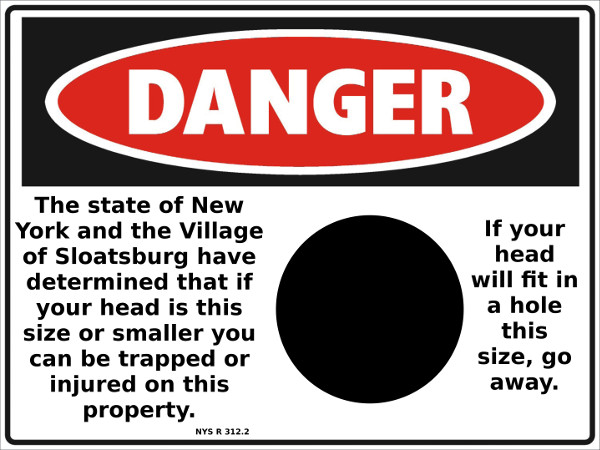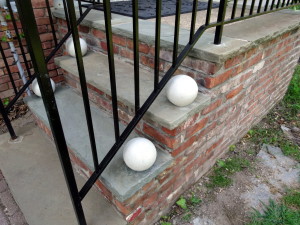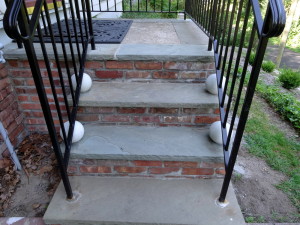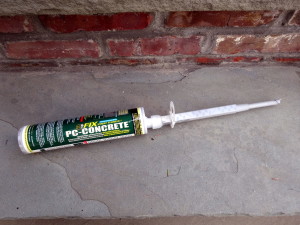…to satisfy the building code. You gotta love living in NY!
Last fall, I rebuilt the crumbling front entry steps and thought the rest would be easy. Hire the making of a set of iron railings and be happy. … Silly me!
Railings have to meet building codes, usually pertaining to rail height and spaces between vertical bars (4 3/8 inches). (Can’t have all the wandering infants getting their heads stuck, can we?) And yes, you guessed it. Anything carrying a code also requires acquiring a building permit, and paying a fee.
I researched the local code and thought I knew everything I needed to know, ordered the railings, and watched with great satisfaction as they were impeccably installed. Those folks used an epoxy cement that will never leak and allow the water incursion that caused previous masonry failure. OK. Done! … Silly me!
Except… in addition to the local code, there’s a NY State code that has one further restriction: on the triangular space between the bottom rail and the tread below. This restriction keeps a wandering infant with a slightly larger head (6 inches) from getting stuck!
Inspection failed…
We gritted our teeth, gnashed and grumbled lots of gnasty words. Then, we explored many options. One of the simpler was to bolt on more iron pieces to the bottom rails. But those would mean drilling into finished materials and risk yet more water incursion, rust etc. My second choice was to have this sign made to actual size and post it at the bottom of the walkway.
In the end, we decided on concrete “garden globes.” They were simple to make. Cast some concrete mix into glass globes (think electric light shades), and then break off the glass.
They are attached to the blue-stone treads with an epoxy product called “PC-Concrete.” An early trial with simple mortar was not strong enough. The epoxy is many times stronger.
BTW, like all epoxies, this is a 2 part product. It is packaged in a “caulk tube” and very nicely mixes the two parts by forcing the materials through a multitude of baffles in the square portion of the attached plastic nozzle. Clever!
Now, we’re debating whether or not to decorate the globes with the faces of anguished children who got their heads stuck.





Love your sarcasm about this — proves that government and regulations have gotten completely out of hand!! I have a suggestion though; does your wife sew? You could make covers for them, sort of like a tea cozy. They could match the season. Orange Jack-o-Lanterns for October, Easter Eggs in April, Elves, Santa and Mrs. Claus in December and so on. Who knows, you could start a whole new trend!!!
Couldn’t you have just installed planters or something?
Elegant solution to a code compliance problem…just as long as it passed inspection 🙂
Building codes can seems like a pain at time, but they are there to protect us all.
It would be total mayhem out there without them…
Love that sign BTW, I should adapt it for my use he he
Bob
You could put photos of the inspectors or code enforcers on the globes as a . . . um . . . tribute? Nah, just paint them the color of the brick.
Like your blog. I came to you via “unlikely boat builder”
Now if you had put those globes on spikes with the same anguished faces I bet it would serve the same purpose…and you don’t have to decorate for Halloween ever again.
Hey Bob.
Unrelated to this entry, may I ask something with regards to your fantastic article on re-sawing (long stock)?
You are using a center finder to mark the middle. As far as I understand this, you cut the stock lengthwise yourself directly before re sawing, so you can be sure that both edges are parallel? Otherwise wouldn’t it be better to use a marking gauge from one edge and be parallel with that edge?
Cheers,
Mariano
Hi Mariano,
There’s only one tiny little thing wrong with your suggestion; the assumption that I prepared the original stock and that the sides were parallel and quite smooth.
That’s not the case. That lumber was rough sawn stock directly from the mill. It might have been somewhat even in size, but it had also sat outside at the lumber yard, exposed to the elements for several years since initial sawing. Very rough, live edge, cedar.
Besides, resawing isn’t precise to very fine tolerances. Both sides needed more surface planing after resawing. So, the center finding approach was good enough and worked well enough on the very rough state of the stock. Marking gauges want smoother surfaces to work from.
Glad you enjoyed the original article. Go resaw some lumber and make beautiful. 🙂
As a quick follow-up Mariano…
On more recent resawing, work done with more typical s2s lumber, I did use a marking gauge, just as you suggest.
[For those wondering how resawing comments … for an article over 2 years old … end up here, it’s because I close comments on aged articles to reduce spam. Mariano couldn’t comment on that old article, so brought his ideas here. And that’s OK with me.]